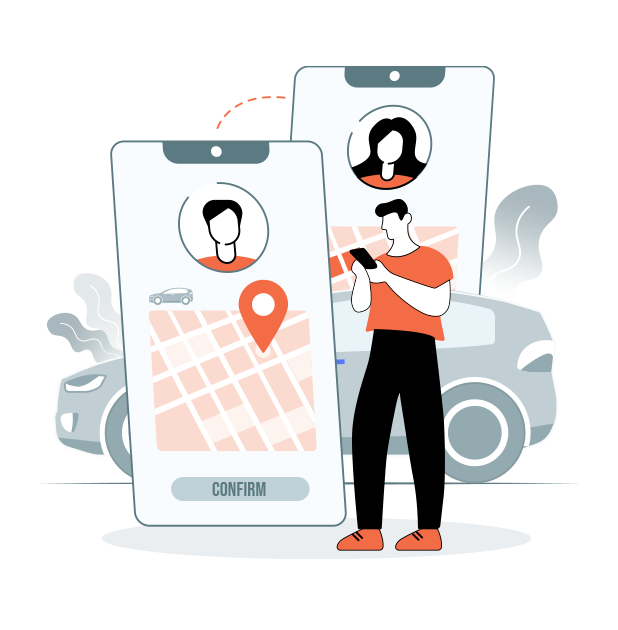185 million dollars! This is the estimate for the market size of ride-sharing apps in 2026.
About 36% of Americans have once ridden using a rideshare app which is twice the numbers in 2015.
So the market looks healthy for a brilliant ride-sharing app and carpool apps. Even before anyone thought of this idea, Uber adapted to it quickly and dominated the market.
But the idea is still fresh. You can leverage the growing market by introducing more user-friendly apps to users.
One important reason to win is to create the best rideshare app from the crowd. Creating an app may look easy today, but to win in the long run, it must be planned and executed properly.
This blog will guide you on creating a ride-sharing app – from researching to app release.
How do ridesharing apps work?
Ride-sharing apps are different from traditional taxi services. In a single ride, more than one user will hire the same taxi. This is an on-demand service.
Real-time communication is a common feature in all these on-demand services. The engaging and compelling on-demand experience that customers expect requires seamless real-time connectivity for everything from live mapping to chat to alerts and notifications.
The main benefits of ride-sharing apps are:
- Users can travel the same distance at less fare,
- Environment-friendly
Now let’s look at how the app works.
Step 1 – A rider has to register and signup. Registration/signup for drivers.
Step 2 – Rider adds the current and drop location. Ride has to be accepted by the driver.
Step 3 – The rider can host the ride by broadcasting the route and destination. Interested people(Guests) will join the ride.
Step 4 – The ride gets started when two or more riders accept the ride.
Step 5 – Making the payment. Every rider will pay according to the distance they travelled. The overall pay is shared among the riders.
Step 6 – Rating for drivers. Both host and guest can rate their ride.
Must have features for ride-sharing apps
You need two apps – A driver app and a rider/passenger app. Features will be different for both sides. But there will be some common features, let’s get started with that.
Common features
Routing and Geo locations
The most important need of the ride-sharing app is the routing and geo-locations.
A GPS will be more helpful in finding the distance and fare calculations. To be more precise ride matching procedure, a routing system will be a mere essential.
Push Notifications
Push notifications in real-time is an important factor for both drivers and riders. It is essential to notify the driver and riders along the way when a new ride appears.
More than just a notification, many times push notifications can act as a call to action in on-demand services.
Account and Profile creation
For both driver and rider accounts, this is mandatory. This will help you understand your customers and tracking for future reference.
You can go with one-step social media registration or email registration. Also, you can follow the form filling to complete the profile. For the driver side, you may need to add documents and photos of the vehicle to complete the profile.
Rider/Passenger side features
- Sign in and Signout
- User profile
- Book a ride
- Share a ride
- Cancel a ride
- Fare calculation
- Real-time tracking
- Chat/call with the driver
- Customer support
- Filters based on location or vehicle
- Review about other passengers
- Rate or review the driver
- Multiple payment options
- My rides
Driver side features
- Sign in /Sign out
- Pick up location
- Accept or reject rides
- Trip information
- Passenger details
- Chat / Call the rider
- Receive payment
- Geolocations
- My rides
- Rating the passengers
Admin side
- Vehicle management
- Driver and rider management
- Payments handling
- Customer support
- Managing dashboard
- Best route management
- Discounts/promo code management
How to create a ridesharing app
Once you confirm the features of the app, get started with the development.
App development is not only about coding and launching. Before we even start coding, we need to do loads of work. There will be a lot of questions and doubts about developing the app.
Every question and doubt get answered or cleared through the process.
Let’s look at different stages of developing the app.
Research
Market research is crucial before we start any business. During this phase, you must understand your customers, competitors, and more. This goes well with app development.
Since there are pioneers in the market, you can reach them to understand where they lag and how you can excel. Large markets have a lot of potentials even though there will be competitors.
During this stage,
- Understand the overall market
- Know about your target customers
- Research your competitors
- List out the tech partners you need to collaborate with
- Search for your niche
Overall market research
The ride-sharing industry has more potential and is expected to reach a market size of over $185 million. Uber generated sales of $10 billion in 2021 only in US and Canada.
Target customers
Understand what your target customers are looking for. You can do a survey or have a direct interview.
For example – Many ride-sharing services only cover a small distance. Riders may be looking for apps that cover long distances.
Competitor research
Create a list of top ride-sharing apps in the global market. Analyze the competitors on Google Play Store and App Store. Look at the rating and feedback. You may find the potential USP for your app.
Understand the top performers and analyze how they bring money to the table. This will give more insights into the mistakes they made at the early stage, which you can easily bypass just by analyzing them. It saves you time and money.
UI/UX designing
Before we start the app development, we need to design the app. The users always welcome simple yet user-friendly designs.
Create a prototype that explains the app’s basic functionality from the register to sign out. Get feedback and improve the prototype.
Make it more interactive for the riders and the drivers.
Development approach
Today we have three kinds of development processes to build an app. Among the following approaches, you can choose one
- Native
- Hybrid
- Cross-platform
Every approach has its own pros and cons. Before you select a method, keep the features and user experience in mind to choose better.
Native apps
When you create native apps, you create apps separately for each platform. Separate apps for Android and iOS.
This kind of app demands more time, resources, and budget but is rich in features and user experience.
Cross-platform app development
Building apps for different platforms using a single code is known as cross-platform app development.
This technique has a quicker time to market and cheaper development costs as a result. Additionally, some cross-platform app development frameworks offer performance on par with native apps.
Hybrid app development
Hybrid app development is building mobile apps that run on multiple platforms, such as iOS, Android, and Windows Phone, using a single codebase. These apps are essentially web apps that are wrapped in a native container, which allows them to access native device features such as the camera, GPS, and push notifications.
As hybrid app development becomes more popular, developers can build apps more quickly and efficiently, as they do not have to make separate versions for each platform.
Tech stack needed to create a ride-sharing app
| Back-end | Node.js, PHP |
| Geolocation | Android – Google Maps Android API, Google Maps; iOS – CoreLocation framework, MapKit |
| Push notifications and SMS | iOS – Apple Push Notification Service, Android – Google Cloud Messaging, SMS notifications – Twilio |
| Payment integration | PayPal, Braintree, and Stripe |
| Cloud server | Amazon Web Services, Google App Engine, Microsoft Azure |
| Database | MySQL, PostgreSQL, and MongoDB |
MVP development
Now you can develop your app. Creating a MVP ( Minimum viable product ) first will be always a better decision.
The main goal of an MVP (Minimum Viable Product) is to create a basic version of a product that has only the essential features needed to demonstrate its value and attract potential investors and early adopters.
This approach allows for testing the product concept with users and gathering feedback for future improvements. The MVP is meant to be a minimal version of the product that can still deliver value to the user.
Test your product
Once you develop the MVP, you can test the product by attracting early adopters to your app.
Before you release the app, you need to check the app with a good-quality analyst team. As ride-sharing apps contain payment transactions and information. It is essential to run mobile app quality assurance before launching.
The first step in improving the product is to gather feedback from early adopters and take it into account when improving the product in an iterative fashion.
How NeoITO help you build a future-ready ridesharing app?
One of the most trusted IT solutions provided in Utah, US, NeoITO loves to build future-ready products.
Our app development team has expertise in developing native and cross-platform apps. You can rely on us, from brainstorming your idea to after-app launch maintenance.
With more than 8 years of experience in the industry, we have helped entrepreneurs transform their idea into reality.
Final thoughts
A lot of technical knowledge and preparation go into building a ride-sharing app. It’s critical to conduct market research, comprehend the competition, and be familiar with the local legal and regulatory environment.
You must select a business strategy for your app, the appropriate technology stack, and development tools.
A strong focus on user experience and customer service is also necessary when developing a successful ride-sharing app. The app needs to be constantly improved based on user feedback so it can meet their needs and preferences.
If you are non-tech person trying to build your own app. Finding a best ride sharing app development company is crucial to rely on as a tech partner.
In general, creating a ride-sharing app is a challenging but worthwhile process. You can create a ride-sharing app that satisfies the needs of your target market by following the steps mentioned in this blog.
FAQ
What is ridesharing?
The idea behind ride sharing is that you share a taxi ride with other people heading to the same place.Popular examples include Uber and Lyft.
What are the essential elements for ridesharing app development?
A perfect USP and a good tech team are essential for ridesharing app development.
Can you build ridesharing apps like Uber?
Sure, the ridesharing app market has a large market size. It is possible to create an app similar to Uber with the right tech partner.
How much does it cost to build a ridesharing app like Uber?
The cost of developing the ride-sharing app uber depends on the features and the tech development process. The average cost will be between $100,000 to $150,000.
How much does it take to build an app like Uber?
It may take from 3-6 months to complete a fully operating MVP of a ride-sharing app.
The main techonology stack of a ridesharing app include:
Kotlin for Android app
Swift for iOS app
Node.js for back-end
Amazon EC2, cloud service
Amazon S3, storage
PayPal / Stripe
Socket.io, for real-time synchronization
Google Maps
Google Places
Google Directions
Card.io
APNS
Firebase




